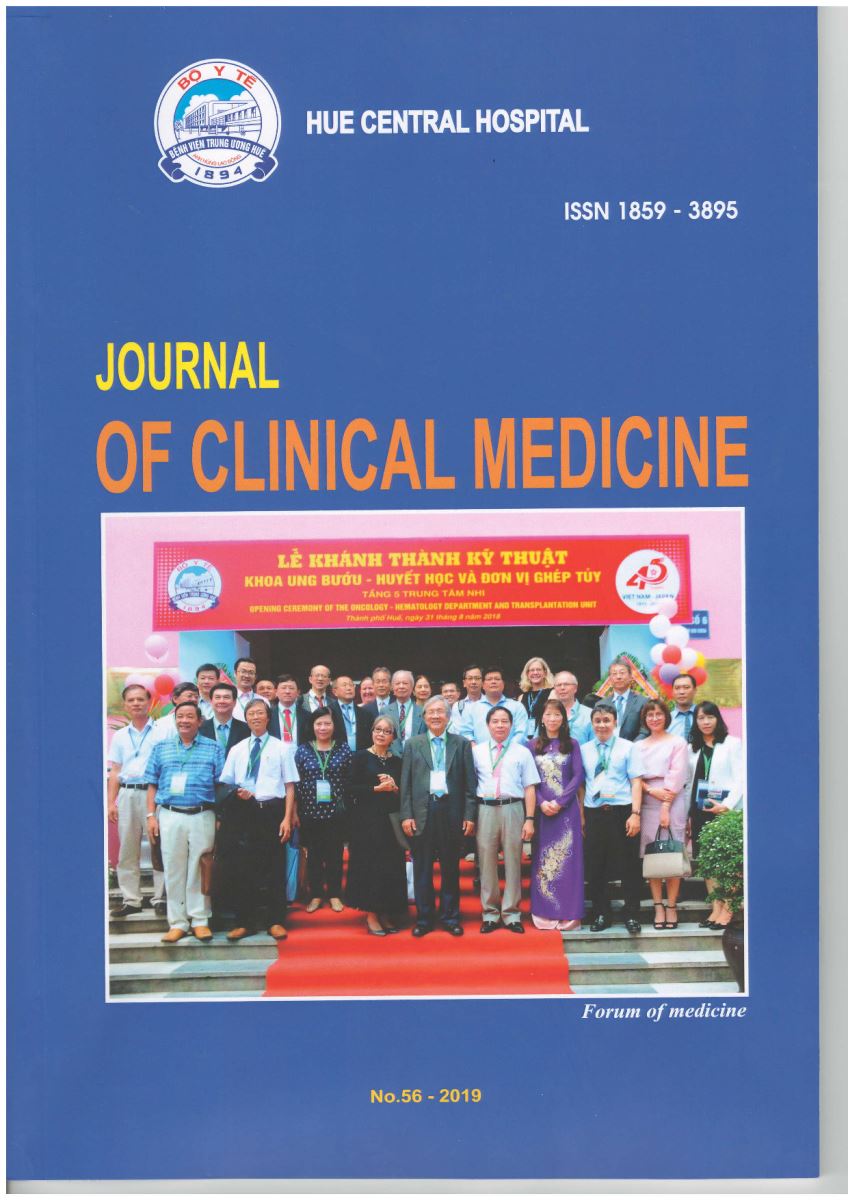Tóm tắt
ABSTRACT
Background: Ketamine is a phencyclidine and cyclohexamine derivative. Ketamine and atropine have been increasingly used in recent years as an effective form of deep sedation/anaesthesia in children in developed countries, but not in developing countries like Vietnam.
Objective: This pioneer trial aimed to evaluate the effectiveness of using ketamine plus atropine as anaesthetic agents for paediatric oncology procedures. From this study, we establish a protocol for anaesthesia in paediatric oncology procedures.
Methods: A descriptive and prospective study on 223 paediatric patients of both sexes (129 males and 94 females) aged 7.2 months to 15 years (mean age: 4.0 ± 3.4 years) and with body weight between 6.5 to 55 kg (mean weight: 15.3 ± 6.2 kg) was carried out from January 2015 to June 2019. The patients had been diagnosed with acute leukaemia, lymphoma or solid tumor. They underwent intrathecal chemotherapy and bone marrow aspirations or bone marrow biopsy for diagnostic as well as therapeutic purposes. After obtaining informed consent from their parents, the research was performed. Datas were analysed by Medcalc software.
Results: The total number of procedures was 810. Bone marrow aspiration was performed 402 times, bone marrow biopsy was done 30 times and intrathecal chemotherapy given 378 times. All procedures were successfully completed. The mean dose of ketamine and atropine used 1.55 ± 0.31 mg/kg and 0.100 ± 0.029 mg respectively. The recovery time was 9.2 ± 7.3 minutes. Only 0.12% experienced apnoea; 1.2% muscular hypertonicity; 4.3% nystagmus, and hyperactivity; 3.7% hypersalivation, 2.5% hallucination and
5.5% vomiting; none of the patients had laryngospasm or transient rash. All of the patients’ parents were satisfied with the use of anaesthetics.
Conclusions: This is a pioneer trial for children in Vietnam. The dose of 1.5 mg/kg intravenous ketamine and 0.1mg atropine were found to be effective and suitable dose in children requiring deep sedation for painful procedures and produce only minimal side effects. We established a protocol with the above doses and continue to apply this in order to reduce pain, trauma, and complications during the procedures.
Tài liệu tham khảo
Kidd, L.R., Lyons, S.C., and Lloyd, G. (2016) Paediatric procedural sedation using ketamine in a UK emergency department: a 7 year review
of practice. Br J Anaesth, 116, 518-23.
Ng, K.C. Ang, S.Y. (2002) Sedation with ketamine for paediatric procedures in the emergency department-a review of 500 cases. Singapore Med J, 43, 300-4.
Heinz, P., Geelhoed, G.C., Wee, C., and Pascoe, E.M. (2006) Is atropine needed with ketamine sedation? A prospective, randomised, double
blind study. Emerg Med J, 23, 206-9.
Traivaree, C., Jindakam, W., Monsereenusorn, C., Rujkijyanont, P., and Lumkul, R. (2014) The factors of ketamine that affect sedation in children with oncology procedures: parent satisfaction perspective. J Med Assoc Thai, 97 Suppl 2, S19-24.
Heilbrunn, B.R., Chang, T.P., and Liu, D.R. (2015) A retrospective comparison of ketamine dosing regimens for pediatric procedural sedation. Eur J Emerg Med, 22, 111-6.
Evans, D., Turnham, L., Barbour, K., Kobe, J., Wilson, L., Vandebeek, C. (2005) Intravenous ketamine sedation for painful oncology procedures. Paediatr Anaesth, 15, 131-8.
Mason, K.P., Padua, H., Fontaine, P.J., and Zurakowski, D. (2009) Radiologist-supervised ketamine sedation for solid organ biopsies in children and adolescents. AJR Am J Roentgenol, 192, 1261-5.
Kye, Y.C., Rhee, J.E., Kim, K., Kim, T., Jo, Y.H., Jeong, J.H. (2012) Clinical effects of adjunctive atropine during ketamine sedation in pediatric emergency patients. Am J Emerg Med, 30, 1981-5.
Slonim, A.D. Ognibene, F.P. (1998) Sedation for pediatric procedures, using ketamine and midazolam, in a primarily adult intensive care unit: a retrospective evaluation. Crit Care Med, 26, 1900-4.
Brown, L., Christian-Kopp, S., Sherwin, T.S., Khan, A., Barcega, B., Denmark, T.K. (2008) Adjunctive atropine is unnecessary during
ketamine sedation in children. Acad Emerg Med, 15, 314-8.
Patterson, A.C., Wadia, S.A., Lorenz, D.J., and Stevenson, M.D. (2017) Changes in blood pressure and heart rate during sedation with ketamine in the pediatric ED. Am J Emerg Med, 35, 322-325.
Shi, J., Li, A., Wei, Z., Liu, Y., Xing, C., Shi, H. (2018) Ketamine versus ketamine pluses atropine for pediatric sedation: A meta-analysis. Am J Emerg Med, 36, 1280-1286.
| Đã xuất bản | 24-01-2025 | |
| Toàn văn |
|
|
| Ngôn ngữ |
|
|
| Số tạp chí | Số 56 (2019) | |
| Phân mục | Nghiên cứu | |
| DOI | ||
| Từ khóa | Keywords: ketamine, atropin, anesthesia, children |

công trình này được cấp phép theo Creative Commons Attribution-phi thương mại-NoDerivatives 4.0 License International .
Bản quyền (c) 2019 Tạp chí Y học lâm sàng Bệnh viện Trung Ương Huế

